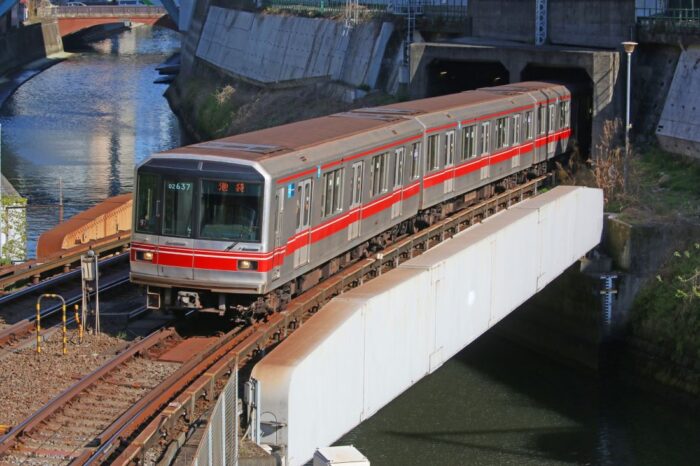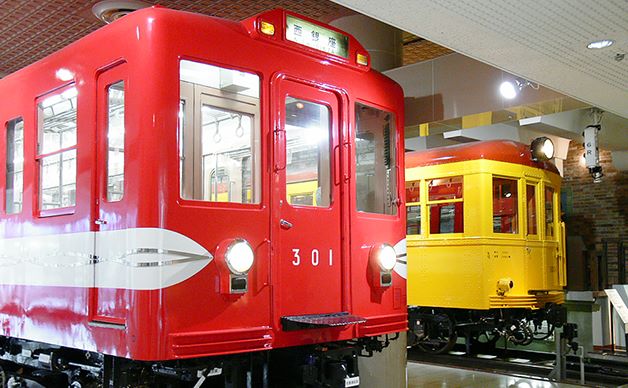The Marunouchi Line runs in a U-shape between Ogikubo Station in Suginami Ward and Ikebukuro Station in Toshima Ward, passing through several popular areas in Tokyo. It is operated by Tokyo Metro and is one of the oldest subway lines in Tokyo, having been in operation since 1954.

The Line is known for its convenience and accessibility and connects to other major subway lines and train stations, including Tokyo Station, which is a major transit hub in the Marunouchi district. It also passes through several popular tourist destinations, such as Shinjuku, Ginza, and Tokyo Dome City.
Route and Stations

The Line has 28 stations, including some of the most important stations in Tokyo, such as Tokyo Station, Shinjuku Station, and Ikebukuro Station. The line has a total length of 27.4 kilometers and takes approximately 48 minutes to travel from one end to the other.
Here are some of the major stations:
- Tokyo Station: Tokyo Station is a major transit hub in the Marunouchi district. It is the eastern terminus of the Marunouchi Line and connects to several other train lines, including the Yamanote Line, the Chuo Line, and the Keihin-Tohoku Line. The tokyo station area also has many shopping and dining locations.
- Otemachi Station: Otemachi Station is located in the heart of Tokyo’s financial district and is a major transit hub for commuters. it connects to several other train lines, including the Chiyoda Line, the Hanzomon Line, and the Tozai Line.
- Shinjuku Station: Shinjuku Station is one of the busiest stations in the world, serving over 3.5 million passengers per day. The station connects to several other train lines, including the Yamanote Line, the Chuo Line, and the Saikyo Line.
- Ikebukuro Station: Ikebukuro Station is another busy station in Tokyo, serving over 2.7 million passengers per day.
Complete list of stations on the Marunouchi Line

Here’s a table of the stations on the Marunouchi Line in Tokyo, Japan, with their connecting lines:
| Station No. | Station Name | Connecting Lines |
|---|---|---|
| M01 | Ikebukuro | JR Yamanote Line, JR Saikyo Line, Tobu Tojo Line, Seibu Ikebukuro Line, Tokyo Metro Yurakucho Line, Tokyo Metro Fukutoshin Line |
| M02 | Shin-otsuka | None |
| M03 | Myogadani | None |
| M04 | Korakuen | Tokyo Metro Namboku Line |
| M05 | Hongo-sanchome | Toei Oedo Line |
| M06 | Ochanomizu | JR Chuo Line, JR Sobu Line, Tokyo Metro Chiyoda Line |
| M07 | Awajicho | Tokyo Metro Shinjuku Line |
| M08 | Otemachi | Tokyo Metro Tozai Line, Tokyo Metro Hanzomon Line, Tokyo Metro Chiyoda Line, Toei Mita Line |
| M09 | Tokyo | JR Yamanote Line, JR Keihin-Tohoku Line, JR Tokaido Line, JR Sobu Line, JR Yokosuka Line, Tokyo Metro Hibiya Line, Toei Asakusa Line, Keiyo Line, Shinkansen |
| M10 | Ginza | Tokyo Metro Hibiya Line, Tokyo Metro Ginza Line |
| M11 | Kasumigaseki | Tokyo Metro Hibiya Line, Tokyo Metro Chiyoda Line |
| M12 | Kokkai-gijidomae | Tokyo Metro Chiyoda Line |
| M13 | Nagatacho | Tokyo Metro Hanzomon Line, Tokyo Metro Yurakucho Line |
| M14 | Akasaka-mitsuke | Tokyo Metro Ginza Line |
| M15 | Nogizaka | None |
| M16 | Roppongi | Toei Oedo Line |
| M17 | Aoyama-itchome | Tokyo Metro Hanzomon Line, Toei Oedo Line |
| M18 | Akasaka | None |
| M19 | Yotsuya | JR Chuo Line, JR Sobu Line, Tokyo Metro Namboku Line |
| M20 | Yotsuya-sanchome | None |
| M21 | Shinjuku-gyoemmae | None |
| M22 | Shinjuku | JR Yamanote Line, JR Chuo Line, JR Sobu Line, JR Saikyo Line, JR Shonan-Shinjuku Line, Odakyu Odawara Line, Keio Line, Tokyo Metro Yurakucho Line, Tokyo Metro Fukutoshin Line, Toei Shinjuku Line, Toei Oedo Line |
| M23 | Nishi-shinjuku | None |
| M24 | Nakano-sakaue | Tokyo Metro Hōnancho Line |
| M25 | Higashi-koenji | None |
| M26 | Shin-koenji | None |
| M27 | Minami-asagaya | None |
| M28 | Ogikubo | JR Chuo Line, JR Sobu Line, Tokyo Metro Hōnancho Line |
Marunouchi Line Map

Fares and Tickets
Fares are based on the distance traveled, with prices ranging from ¥170 to ¥320. Passengers can purchase tickets at ticket machines located at each station.
Attractions Near the Marunouchi Line

The line runs through many popular destinations in the city. Here are some of the attractions near the Marunouchi Line that are worth visiting:
- Tokyo Station and Marunouchi Area: Tokyo Station is one of the busiest train stations in the world, and the Marunouchi area surrounding it is a bustling business district with many shops and restaurants. You can explore the historic Tokyo Station building, which dates back to 1914, or take a stroll through the picturesque Marunouchi Brick Square.
- Imperial Palace: Just a stone’s throw away from the Marunouchi exits of Tokyo Station lies the Imperial Palace, the primary residence of the Emperor of Japan. You can take a guided tour of the palace grounds or simply enjoy a peaceful walk around the moat and gardens.
- Ginza: Ginza is a high-end shopping district located on the eastern end of the Marunouchi Line. You can find luxury brands and department stores, as well as traditional Japanese crafts and souvenirs. Ginza is also known for its fine dining and nightlife and is home to the Art Aquarium Museum GINZA.
- Korakuen: Korakuen is a neighborhood located near the Korakuen Station on the Marunouchi Line. It is home to several attractions, including the Tokyo Dome City amusement park, the Koishikawa Korakuen Gardens, and the Tokyo Dome baseball stadium.
- Shinjuku: Shinjuku is a major commercial and entertainment district located at the western end of the Marunouchi Line. There are countless restaurants, and bars here, as well as the Tokyo Metropolitan Government Building, and the fantastic Shinjuku Gyoen National Garden.
History of the Marunouchi Line

It is one of the older subway lines in the metropolis. It first opened in 1954, making it the second subway line after the Ginza Line. it runs in a U-shape between Ogikubo Station in Suginami and Ikebukuro Station in Toshima, with a total length of 24.2 kilometers and 28 stations.
It was named after the Marunouchi district, which is known for its business and commercial activities, and the line was built to connect the major business and commercial areas of Tokyo, including the Tokyo Station and the Shinjuku Station.
In 2008, the line was extended from Ikebukuro Station to Honancho Station, adding three new stations to the line. The extension also included the construction of a new train depot in Nakano, which helped to increase the line’s capacity and efficiency.

Today, the Marunouchi Line is one of the busiest subway lines in Tokyo, with an average daily ridership of over 1.2 million passengers. It is also known for its punctuality and reliability, with trains running every 2-3 minutes during peak hours.
The Sum Up

Overall, the Marunouchi Line is a crucial part of Tokyo’s transportation system, connecting commuters and tourists to some of the city’s most popular destinations. With its modern trains, efficient service, and convenient stations, it is no wonder why the Marunouchi Line is a favorite among locals and visitors alike.
Whether you are looking to explore the bustling streets of Tokyo or simply need to get to work, the Marunouchi Line offers a reliable and convenient way to travel. With its extensive network of stations and connections to other subway lines, you can easily navigate the city and reach your destination in no time.
As you ride the Marunouchi Line, take the time to appreciate the unique architecture and design of each station. From the historic red-brick Tokyo Station to the modern and sleek Otemachi Station, each stop on the Marunouchi Line has its own distinct character and charm.
Where To Stay In Tokyo
Tokyo visitor levels are currently at an all-time high so make sure to book your hotels early. Tip most hotels booked with booking.com have free cancelation so book as soon as you know your date and you can always cancel if you change your mind.






